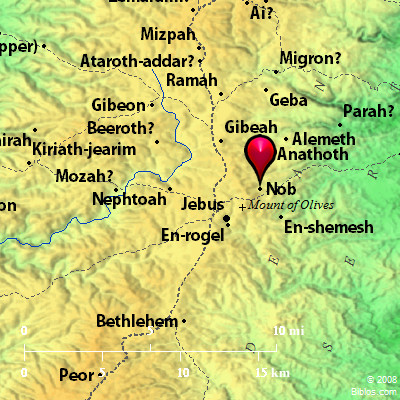Atlas  Nob and surrounding area Maps Created using Biblemapper 3.0 Additional data from OpenBible.info You are free to use up to 50 Biblos coprighted maps (small or large) for your website or presentation. Please credit Biblos.com. Occurrences 1 Samuel 21:1 Then came David to Nob to Ahimelech the priest. Ahimelech came to meet David trembling, and said to him, "Why are you alone, and no man with you?"1 Samuel 22:9 Then Doeg the Edomite, who stood by the servants of Saul, answered and said, "I saw the son of Jesse coming to Nob, to Ahimelech the son of Ahitub. 1 Samuel 22:11 Then the king sent to call Ahimelech the priest, the son of Ahitub, and all his father's house, the priests who were in Nob: and they came all of them to the king. The First Book of Kings 1 Samuel 22:19 He struck Nob, the city of the priests, with the edge of the sword, both men and women, children and nursing babies, and cattle and donkeys and sheep, with the edge of the sword. Nehemiah 11:32 at Anathoth, Nob, Ananiah, Isaiah 10:32 This very day he will halt at Nob. He shakes his hand at the mountain of the daughter of Zion, the hill of Jerusalem. Encyclopedia NOBnob (nobh; Codex Vaticanus Nomba; Codex Alexandrinus Noba, and other forms): An ancient priestly town to which David came on his way South when he fled from Saul at Gibeah (1 Samuel 21:1). Here he found refuge and succor with Ahimelech. This was observed by Doeg the Edomite, who informed the king, and afterward became the instrument of Saul's savage vengeance on the priests, and on all the inhabitants of the city (1 Samuel 22). The name occurs in Nehemiah 11:32 in a list of cities, immediately after Anathoth. In Isaiah's ideal account of the Assyrians' march against Jerusalem, Nob is clearly placed South of Anathoth. Here, says the prophet, the Assyrian shall shake his hand at the mount of the daughter of Zion, the hill of Jerusalem. It was a place, therefore, from which the Holy City and the temple were clearly visible. NOB, perhaps at el Isawiyeh 1 1/2 m. n.e. of Jerusalem. Referred to in 1 Sam. 22:19 and five other places. Strong's Hebrew H5011: Noba priestly city, perhaps also a place North of Jer. |



